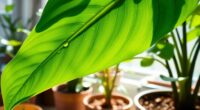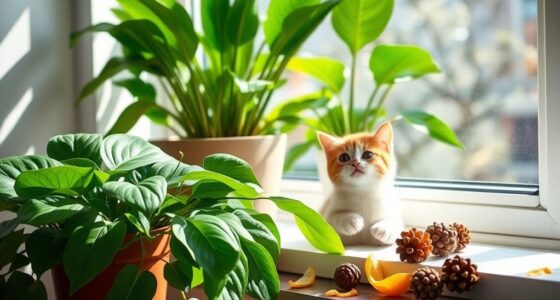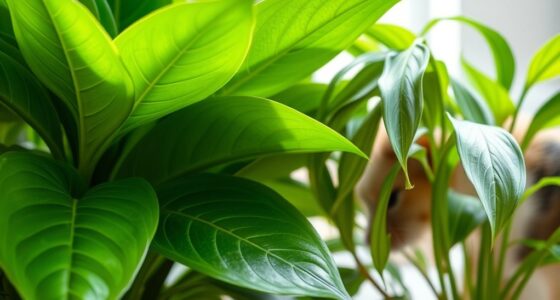When choosing indoor plants safe for your cat, opt for non-toxic options like African Violets, Cat Grass, Spider Plants, and Parlour Palms. These plants not only won’t harm your feline friend but can also improve your home’s air quality. For busy lifestyles, low-maintenance varieties like Ponytail Palms and Cast Iron Plants work well. Keeping plants out of reach and monitoring your cat’s behavior around them are essential steps for a safe indoor environment. Discover more tips to create a cat-friendly garden!
Key Takeaways
- Safe indoor plants for cats include African Violets, Cat Grass, and Spider Plants, all of which are non-toxic.
- Plants like Parlour Palm and Peperomia are also cat-friendly and easy to care for.
- Low-maintenance options like Ponytail Palm and Cast Iron Plant are ideal for busy cat owners.
- Monitor your cat’s behavior around plants to prevent ingestion of any potentially harmful substances.
- Use vertical gardening techniques to keep plants out of reach and incorporate sensory plants for engagement.
Understanding Plant Toxicity for Cats

When you bring plants into your home, it’s essential to understand their potential toxicity for your feline friend. Some common plants like lilies, aloe vera, and sago palm can pose serious health risks. Symptoms of toxicity may range from mild irritation to severe issues like kidney failure, depending on the plant and the amount ingested. Toxicity occurs due to specific compounds that harm your cat if consumed. To keep your furry companion safe, ensure toxic plants are out of reach and opt for non-toxic alternatives, such as non-toxic houseplants like Boston Fern and Spider Plant. Additionally, choosing non-toxic XL houseplants can provide aesthetic appeal without compromising your cat’s safety. Regular veterinary check-ups ensure pet health and can help identify any issues that may arise from accidental plant ingestion. Being aware of common toxic plants can further enhance your efforts to protect your cat. In case of exposure, contacting a veterinarian or the ASPCA Animal Poison Control hotline is crucial. Being informed and proactive can help create a safer environment for both you and your beloved pet.
Importance of Safe Plant Selection
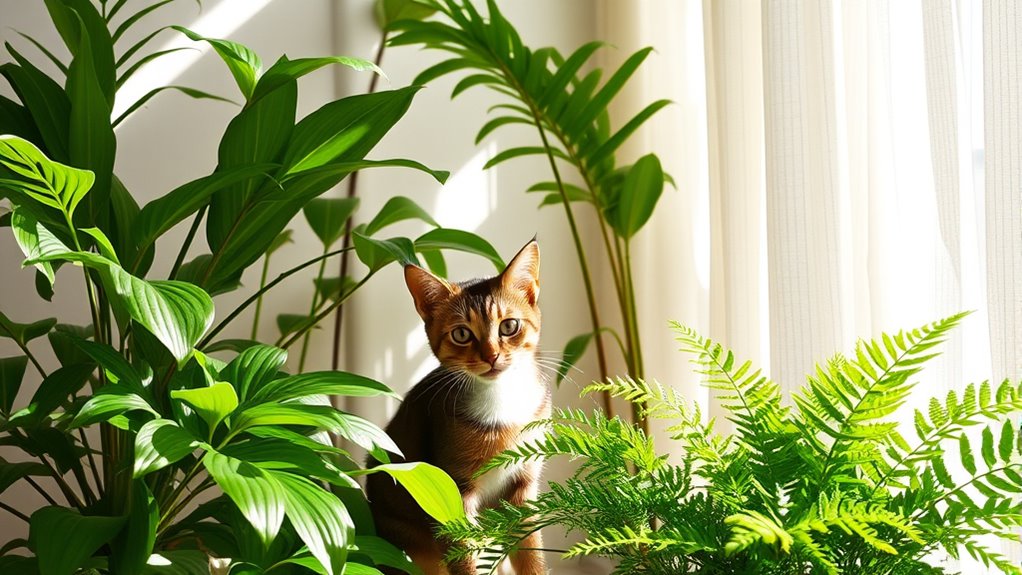
Choosing safe plants for your home is crucial, especially if you share your space with a curious cat. Many common houseplants can be toxic, leading to symptoms like vomiting, diarrhea, or even organ failure. Additionally, it’s important to be aware of your legal obligations regarding pet care and safety, as neglecting this can have consequences. For instance, certain dog owners often overlook toxic plants that can harm their pets as well.
By selecting cat-friendly plants, you not only protect your furry friend but also improve your indoor air quality. These plants filter toxins and release oxygen, benefiting both you and your cat. Moreover, safe plants provide mental and physical stimulation, reducing stress and encouraging healthy behaviors. Remember, in 2020 alone, over 10,000 pets were hospitalized due to plant ingestion. Choosing the right plants can also foster spiritual connections that enhance your well-being and that of your pet.
Prioritizing safe plant selection helps create a nurturing environment where both you and your cat can thrive without worry. Consider incorporating cat-safe house plants like the Rattlesnake Plant or Spider Plant to enhance your living space while ensuring your pet’s safety.
Top Cat-Friendly Indoor Plants
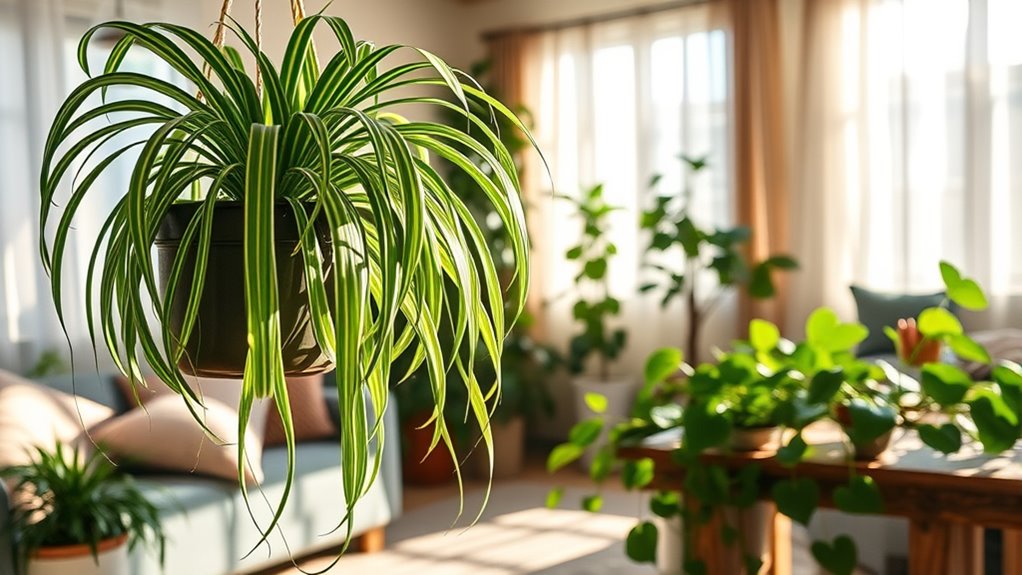
If you’re looking to brighten your home while keeping your feline friend safe, consider these top cat-friendly indoor plants.
African violets add vibrant blooms in purple, pink, and white. Cat grass is perfect for grazing, promoting your cat’s digestive health and providing a natural source of fiber that can aid in digestion. Additionally, cat grass contains nutritional benefits that support overall wellness. Implementing plant care routines can also help ensure that your pets remain in a safe environment free from harmful substances.
The spider plant is easy to grow and purifies the air, while the parlour palm brings height and tolerates some neglect. Additionally, these plants are all non-toxic varieties that ensure your pets can explore without worry.
Peperomia requires minimal care and thrives in indirect sunlight. For a playful touch, catnip stimulates appetite and encourages fun behavior.
Parsley and lemongrass are safe for nibbling, offering nutritious benefits.
With these options, you can create a beautiful, safe, and inviting space for both you and your furry companion!
Low-Maintenance Options for Busy Cat Owners

For busy cat owners, finding indoor plants that require minimal care can be a game-changer. Consider the Ponytail Palm and Rainbow Bush, both drought-tolerant options that need infrequent watering. If you’re looking for plants that adapt to different lighting, the Parlor Palm and Boston Fern thrive in various conditions without hassle. The Cast Iron Plant is perfect for those who might forget to water, as it can withstand neglect. Additionally, many plants are known for their low power consumption, which can be beneficial for maintaining a sustainable indoor environment. For a touch of color, the Friendship Plant and Mosaic Plant offer unique leaves, though they prefer higher humidity. Plus, many of these options, like the Spider Plant, naturally resist pests, reducing your maintenance even further. Additionally, incorporating cat-safe plants will give you peace of mind knowing your feline friends can explore their environment safely. This is particularly important as human rights violations in various regions can affect the availability of pet-friendly resources. Many of these plants, like the Spider Plant, also provide nutritional benefits through their ability to purify the air. Enjoy the beauty of plants without the stress!
Plants Suitable for Different Lighting Conditions
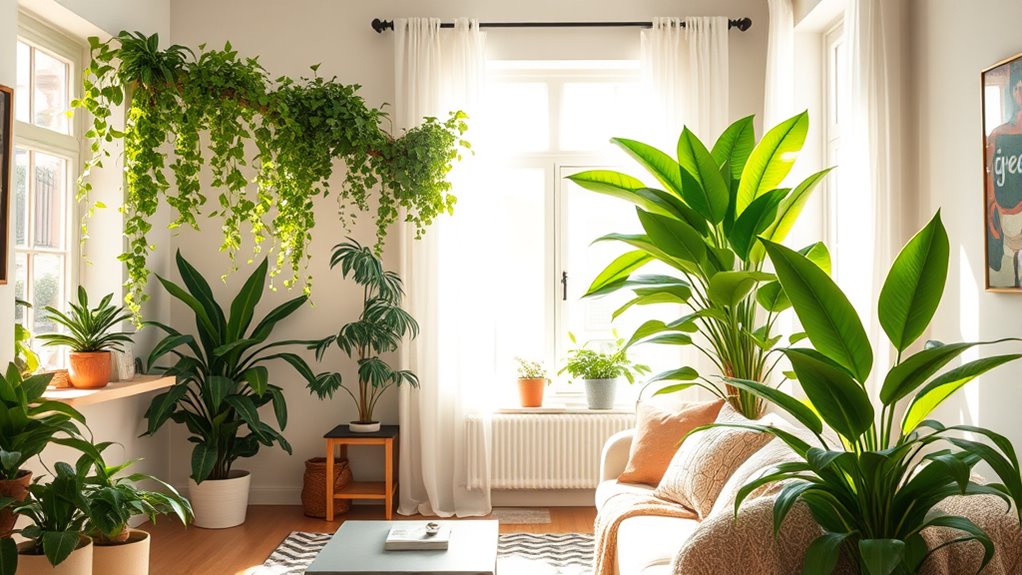
While you may think finding the right indoor plants is challenging, selecting varieties that thrive in different lighting conditions can simplify your choices.
For low-light areas, consider the Cast Iron Plant or Spider Plant, both cat-safe and easy to care for. The Cast Iron Plant is particularly known for its ability to grow with minimal attention and care, just like how some dogs can tolerate certain foods better than others. Additionally, these plants can flourish in urban areas where natural light may be limited, making them ideal for those looking to enhance their indoor environment.
If you have bright, indirect light, opt for the Hoya or Prayer Plant for vibrant foliage and fragrant blooms.
In partial shade, the Bird’s Nest Fern and Chinese Money Plant thrive beautifully while staying safe for your feline.
If you need plants for high-humidity environments, the Brazilian Orchid and Calathea are excellent options.
For versatility, the Parlor Palm and Areca Palm adapt well to various lighting conditions, ensuring your space remains lush and inviting for both you and your cat.
Air Purification Benefits of Cat-Safe Plants
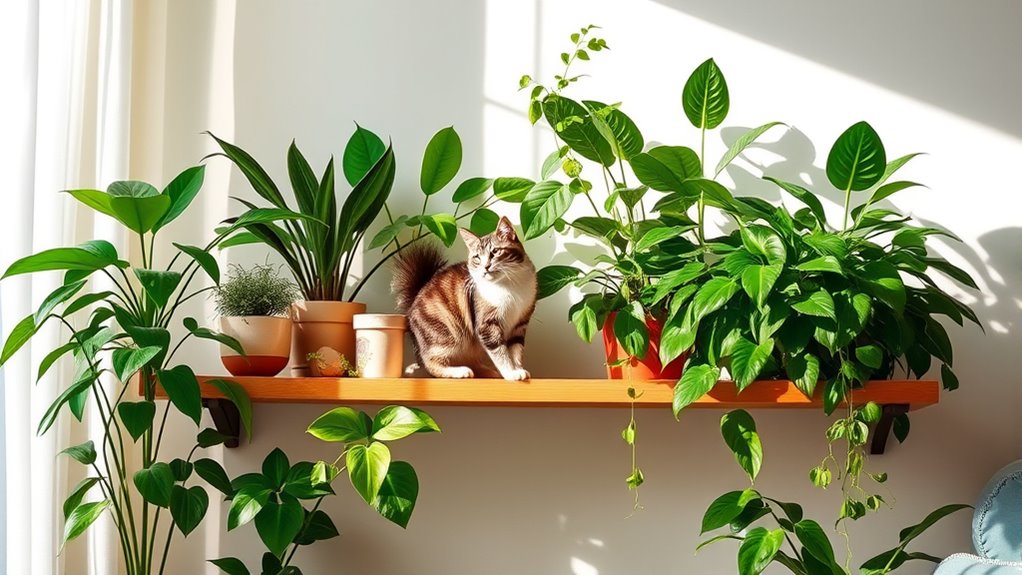
Indoor plants not only enhance your space but also contribute significantly to air quality, especially when you choose varieties that are safe for your feline friends.
Plants like the Spider Plant, Calathea family, and Areca Palm absorb carbon dioxide and release oxygen, making your home feel fresher. They also remove harmful pollutants like benzene and formaldehyde, which can irritate your respiratory system and your cat’s. Additionally, incorporating plants like the Cast Iron Plant can improve air quality by capturing toxins like carbon monoxide. Notably, these plants can also help boost hydration and support overall wellness in your living environment. Regularly maintaining your air purifier can further enhance the effectiveness of these plants in improving indoor air quality. For optimal results, consider adding HEPA filter vacuums to your cleaning routine, as they help eliminate allergens and pollutants from your living space.
Tips for Creating a Cat-Friendly Indoor Garden
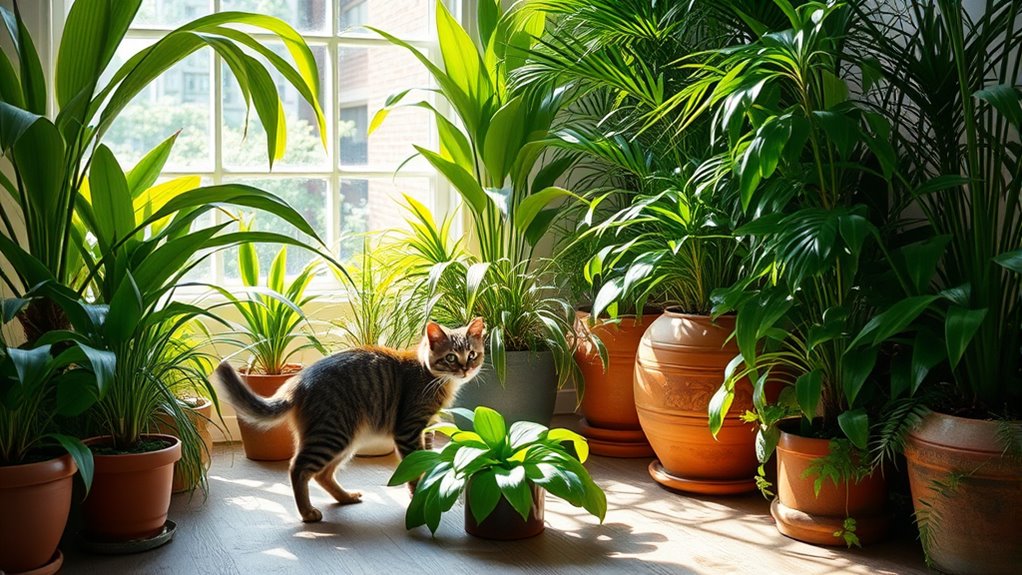
Creating a cat-friendly indoor garden can be a rewarding experience that enriches your home and keeps your feline companion safe.
Start by selecting non-toxic plants like African violets, spider plants, catnip, and parlour palms. Use vertical gardening techniques, such as hanging baskets, to keep plants out of reach. For example, consider adding a Pineapple Plant which is non-toxic to cats and can thrive in bright spots. Essential oils from some plants can also provide a pleasant aroma without harming your pets. Additionally, ensure you conduct patch tests when using any essential oils to avoid potential skin irritation. Incorporating protein-packed seeds can also enhance the overall health benefits of your indoor garden.
Choose safe, non-toxic plants like African violets and catnip, and utilize vertical gardening to keep them out of your cat’s reach.
Mix textures and colors to visually stimulate your cat and ensure accessible paths for easy movement. Incorporate sensory plants with varying smells and textures for extra engagement.
Regularly maintain your garden by watering when the soil is dry, pruning for shape, and monitoring for pests.
Finally, include catnip and cat grass to encourage playful behavior while providing safe spots for your cat to explore and enjoy.
Plant Placement Strategies to Keep Cats Safe

To keep your feline friend safe, strategically placing plants throughout your home is essential. Consider using hanging plants in macrame holders or on high shelves to keep them out of your cat’s reach. A designated conservatory or plant room can be an ideal space, ensuring your plants are safe and thriving. Incorporating non-toxic plants in these areas can further enhance the safety of your home environment. Additionally, being aware of toxic foods for pets can help you make informed choices about which plants to keep. Enclosed terrariums or glass cabinets protect plants while still showcasing their beauty. You can also utilize high shelves that your cat can’t easily access. Plant hangers are another great option for suspending plants above curious paws. Many family-friendly amenities in homes can also create a safe environment for your pets and plants alike. Consider incorporating safe indoor plants that not only beautify your space but also provide a secure atmosphere for your pets.
Monitoring Your Cat’s Behavior Around Plants

While you might love the greenery in your home, it’s crucial to keep an eye on your cat’s interactions with your plants. Cats are naturally curious, often drawn to leaves for their texture and movement. This instinct can lead them to munch on plants, some of which may be toxic. Watch for signs of toxicity, like vomiting or lethargy, especially if your cat shows unusual behavior. To discourage them, consider using deterrents like citrus sprays or double-sided tape around your plants. Provide safe alternatives, like cat grass or catnip, to satisfy their instincts without risk. Additionally, many cats eat plants instinctively to search for vitamins that may be lacking in their diet.
Frequently Asked Questions
Can Cats Be Allergic to Non-Toxic Plants?
Yes, cats can be allergic to non-toxic plants. Just because a plant is safe doesn’t mean your feline friend won’t react to it.
Allergies can occur due to pollen, dust, or even the plant’s texture. If you notice symptoms like sneezing or skin irritation after introducing a new plant, it’s best to remove it and monitor their reaction.
Consulting your vet can help you determine the cause and find suitable alternatives for your home.
How Can I Tell if My Cat Ate a Toxic Plant?
Imagine your cat as a curious explorer, prowling through the jungle of your home.
If you suspect your adventurous feline nibbled on a toxic plant, watch for signs like vomiting, diarrhea, or mouth irritation.
Keep an eye on their breathing and energy levels too.
If symptoms arise, don’t hesitate—call your vet immediately.
Early action can turn that jungle trek back into a cozy, safe haven for your furry friend.
Are There Any Plants That Are Safe for Kittens?
When you’re looking for plants that are safe for kittens, there are plenty of great options.
Consider the Boston Fern and Spider Plant, both of which are non-toxic and easy to care for.
Cat Grass is also a fun, safe choice your kitten can munch on.
If you want something colorful, African Violets or Moth Orchids add beauty without the worry.
With these plants, you can enjoy greenery while keeping your furry friend safe!
What Should I Do if My Cat Shows Symptoms After Chewing a Plant?
If your cat’s feeling a bit under the weather after nibbling on a plant, don’t panic.
Start by gently removing any plant material from their mouth or fur. It’s wise to contact your veterinarian for guidance, and it helps to have a sample of the plant handy.
Keep an eye on their symptoms, like vomiting or lethargy. If things worsen, don’t hesitate to seek immediate veterinary care. Your furry friend deserves the best!
Can Indoor Plants Affect My Cat’s Respiratory Health?
Yes, indoor plants can affect your cat’s respiratory health.
Fungal spores and contaminated soil might pose risks if inhaled, leading to potential lung infections. Additionally, some plants can trigger allergic reactions, impacting their breathing.
While many plants improve air quality, toxic varieties can negate these benefits.
Ensure you keep your indoor space well-ventilated and monitor your cat for any signs of respiratory distress to maintain a safe environment.
Conclusion
In the lush tapestry of your home, choosing cat-safe plants weaves a protective thread for your furry friend. By selecting the right greenery, you create a sanctuary where both you and your cat can thrive, free from worry. These vibrant companions not only brighten your space but also purify the air, making every breath a little sweeter. So go ahead, cultivate your indoor garden, and let your home blossom into a safe haven for both you and your curious kitty.


